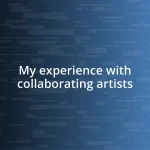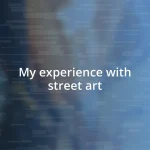Key takeaways:
- Art exhibitions facilitate deep emotional connections and diverse narratives, enhancing viewers’ appreciation and understanding of societal themes.
- Engagement with artists and curators adds layers of meaning to the art, transforming the viewing experience and fostering richer interpretations.
- Current trends in art exhibitions, such as the use of technology, community involvement, and sustainability practices, are reshaping the way art is created, displayed, and perceived.

Understanding art exhibitions
Art exhibitions serve as a vivid window into the artist’s mind, revealing emotions, stories, and cultural expressions that words often fail to convey. I remember the first time I stood in front of a breathtaking installation; it was as if the world around me vanished, leaving only the art’s powerful message. Have you ever felt that rush of connection when encountering a piece that resonates deeply with your own experiences?
Understanding art exhibitions also means appreciating the diverse narratives they present. Each exhibition is curated to invite viewers into an exploration of themes—whether it’s societal issues, personal struggles, or cultural heritage. I often find myself pondering how curators select works that create a dialogue, sparking questions that linger long after the visit. Isn’t it fascinating how art can both challenge and expand our perspectives?
Moreover, the setting of an exhibition plays a crucial role in shaping our perceptions. I once visited a gallery housed in an old factory, where the juxtaposition of contemporary art against the gritty backdrop transformed each piece’s impact. Can you recall an environment that maximized your appreciation for art? It’s in these spaces that we can truly grasp the transformative power of art, allowing us to explore not just the works on display but also the broader conversations they ignite.

Reasons to visit art exhibitions
Visiting art exhibitions offers a unique opportunity to engage with creativity and innovation firsthand. I distinctly remember roaming through a vibrant contemporary art show, where every piece seemed to challenge my understanding of normalcy. There’s something exhilarating about witnessing fresh ideas manifest in tangible forms; it can be a catalyst for my own creativity.
The diverse experiences at exhibitions create a shared space for connection among visitors. I once attended an interactive art display that encouraged communal participation; it was amazing to see strangers draw together on a massive canvas. This sense of belonging, fueled by collective creativity, often deepens my appreciation for both the art and the people around me. Have you ever felt united with others through a common experience in the art world?
Lastly, exhibitions frequently serve as a springboard for meaningful conversations about art and society. I remember discussing the thought-provoking themes of an exhibition on social justice with fellow attendees, and it struck me how art can ignite change. Engaging with different perspectives helps me reflect on my views and inspires action beyond the gallery walls. In what ways do you think art can affect social conversations?
| Reason | Personal Insight |
|---|---|
| Engagement with creativity | Experiencing fresh ideas can be exhilarating, sparking my own creativity. |
| Connection among visitors | Community participation often deepens appreciation for art and relationships. |
| Conversations about society | Art can ignite important discussions that inspire action beyond the exhibition. |

How to analyze art critically
To analyze art critically, I often start by considering the elements at play within the piece. This includes examining composition, color, form, and texture. Each element tells a story and influences how I perceive the artwork. I remember a moment in front of a large abstract painting where the chaotic swirls and bold colors struck me as a snapshot of turmoil. I couldn’t help but wonder what the artist was feeling during the creation process.
Here’s a simple checklist to guide your critical analysis:
- Observe the details: What immediate feelings or thoughts does the piece evoke?
- Contextual understanding: Consider the artist’s background and the historical time frame of the work.
- Theme exploration: What themes or messages are being communicated?
- Personal reaction: Reflect on how this art personally resonates with you.
- Formal techniques: Note the techniques—what do they reveal about the artist’s intent?
When I delve into these aspects, it often enriches my appreciation and deepens my connection to the artwork. I feel that art is not just about what I see but about what I feel and think as I engage with it.

Engaging with artists and curators
Engaging with artists and curators during exhibitions truly transforms my experience. I recall a specific event where I participated in a Q&A session with the curator after viewing a thought-provoking installation. Hearing their insights on the creative process and the intent behind the artwork deepened my understanding and made me appreciate the exhibition even more. Have you ever thought about how a curator’s perspective can illuminate the subtleties of an artwork?
There’s an undeniable thrill in chatting with artists directly. At one exhibition, I approached a painter whose work deeply resonated with me. In our conversation, I learned about the stories behind her pieces, filled with personal struggles and triumphs. This connection added layers of meaning to what I saw and made me feel more emotionally invested. Don’t you think that knowing the artist’s journey can change how we interact with their work?
Curators also play a significant role in shaping our viewing experience. I’ve noticed that a well-organized exhibition can guide my interpretation of the art. For instance, in one gallery, the curator thoughtfully arranged pieces in a way that told a compelling narrative, sparking curiosity and encouraging deeper reflection. How do you think the arrangement of artwork affects your perception of the overall message? It’s these intimate engagements that create a richer, more fulfilling exploration of art.

Tips for enhancing your experience
I find that preparing for an art exhibition enhances my overall experience significantly. Before I go, I like to research the artists and their works so that I have some background knowledge. It’s fascinating to discover their artistic journeys and inspirations. Have you ever walked into an exhibition and felt utterly lost? Knowing a bit about the context always helps me appreciate the pieces on display.
Another tip I swear by is to take my time with each artwork. Instead of rushing from one piece to the next, I often spend a few minutes absorbing the details and nuances. One memorable moment for me was lingering in front of a mesmerizing sculpture. The way the light danced on its surface sparked pure joy and provoked intense reflection. It reminded me that art isn’t just a visual experience, but a dialogue between the viewer and the creator.
Finally, I recommend bringing a notebook or a sketchbook. I’ve found that jotting down my thoughts or even doodling what resonates with me keeps the experience alive long after I leave the exhibition. It’s as if I’m capturing a snippet of my inspiration, which later fuels my own creativity. Have you ever felt that surge of ideas after viewing something beautiful? Writing it down makes those fleeting moments more tangible and enduring.

Exploring art exhibition trends
I’ve observed that art exhibitions have started to embrace technology in fascinating ways. Virtual reality installations, for example, invite viewers to step into immersive environments that enhance the storytelling aspect of art. I remember trying out a VR experience at a contemporary art exhibition where I was transported into a surreal dreamscape. It completely shifted my perspective on how we interact with art—do you think technology can redefine our emotional connections to artwork?
Moreover, I’ve seen a growing trend in community involvement, where local artists showcase their work alongside more established names. This blend not only democratizes art but also amplifies diverse voices. At one exhibition, I discovered a young artist whose unique style and narrative struck a chord with me. It’s exciting to think that these spaces can nurture emerging talent—don’t you agree that fostering local artists enriches the artistic landscape?
Sustainability is another crucial trend shaping the future of art exhibitions. Many galleries are now using eco-friendly materials and practices, and I’ve personally been inspired by installations that creatively repurpose existing objects. I remember walking through a space where every piece was made from recycled materials; it was eye-opening and left me pondering our responsibility towards art and the environment. How do you feel about art that takes a stand on social issues? I believe it often acts as a catalyst for change in how we view the world.












